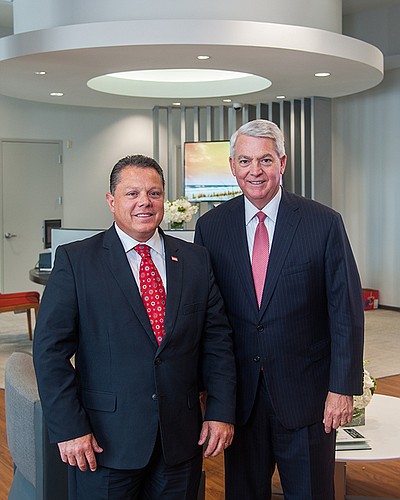- December 22, 2024
-
-
Loading

Loading

If it were headquartered in Florida, Synovus Bank would be the state's largest bank by assets under management.
Instead, the Columbus, Ga.-based bank, with $28.9 billion in assets, makes Florida a large part of its growth strategy. The latest move in that regard is a new branch in the Ellis Building on Main Street in downtown Sarasota. The bank now has 264 branches in Georgia, Florida, Alabama, South Carolina and Tennessee.
Synovus CEO Kessel Stelling was at the grand opening of the new Sarasota branch, which replaces what was the main area office for Bank of America. Stelling spoke with the Business Observer about Synovus and the banking industry at the ribbon-cutting event. Here are highlights of the conversation:
Florida growth
The Gulf Coast market, one of the newer areas the 127-year-old bank has entered, makes up more than $1 billion of Synovus' assets, Stelling says. He attributes that growth to a combination of a strong staff, low turnover rate and incorporation of technology with traditional banking. “Even though technology plays a huge role in our success, we still believe that personal touch means a lot to most of our customers,” he says.
The new branch in Sarasota reflects that approach and is a sign of things to come for Synovus' Florida market and the other branches in the Southeast. “The look, the feel, the introduction of technology, the open view from the street,” Stelling says. “We're going to do more branches like this where we have less square footage and more technology but a very strong dose of the human touch when you walk in that door.”
Community banking
Stelling's approach with Synovus is to combine the human touch with its large scale. “We really do bring the resources, the capital, the technology, the special product offerings and lending expertise and the private wealth services,” he says. “We bring all that a larger bank can offer, but we try to deliver it in a community bank way.”
 Stelling acknowledges smaller community banks without the ability to scale face a challenge in earning returns to satisfy investors. Because of that, he's one of many bankers who expects more industry consolidation.
Stelling acknowledges smaller community banks without the ability to scale face a challenge in earning returns to satisfy investors. Because of that, he's one of many bankers who expects more industry consolidation.
“We'd like to get every piece of business we can in this town, but I think a healthy community banking system is good for all of us,” he says. “We work with other banks and other bankers, and at the end of the day, there's plenty of business to go around, especially in Florida.”
Regulatory environment
Stelling is also one of many bankers who say the 2010 Dodd-Frank financial reform bill brought in a wave of unnecessary regulatory burdens. Now he believes the industry is overregulated. “I've shared that with legislators, congressmen and senators on both sides of the aisle and none of them disagreed,” he says.
Stelling didn't share specifics, but says it's clear that some of the policies “have nothing to do with the financial crisis.”
Regulations, on the other hand, sparked some changes at Synovus that were necessary and good for the bank, Stelling says. “A lot of the investments we made in risk, in compliance, in technology to support those, in cyber security, those investments are not mandated by regulators,” he says. “They're things we have to do.”
Follow Steven Benna on Twitter @steve_benna